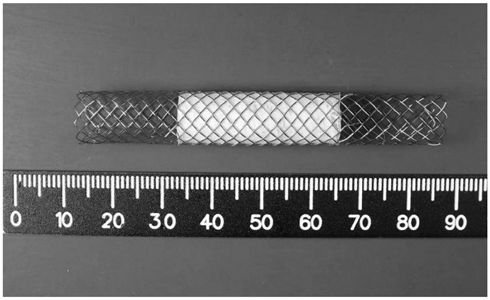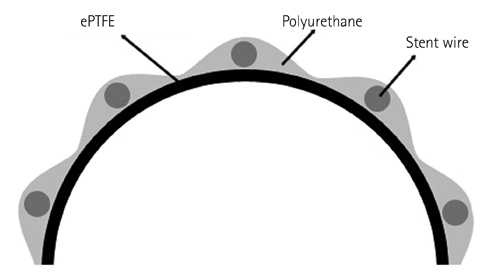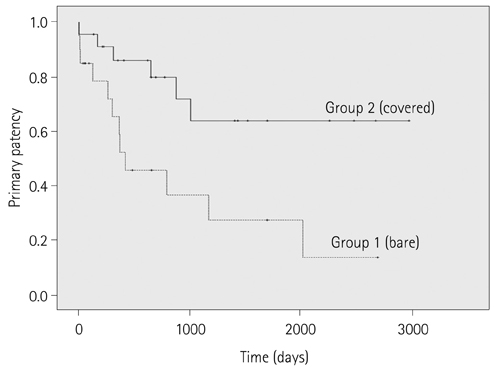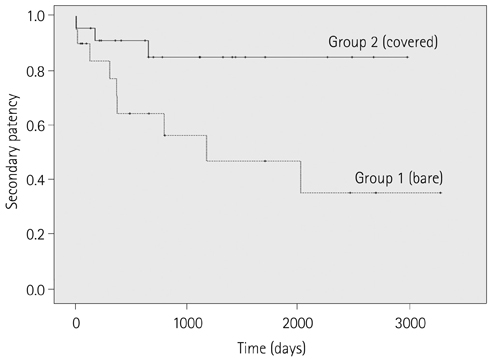J Korean Soc Radiol.
2013 Aug;69(2):113-121. 10.3348/jksr.2013.69.2.113.
Comparison of Shunt Patency and Clinical Outcomes between Bare Stents and Expanded Polytetrafluoroethylene-Covered Stents for Transjugular Intrahepatic Portosystemic Shunts
- Affiliations
-
- 1Department of Radiology, University of Ulsan College of Medicine, Ulsan University Hospital, Ulsan, Korea. stent@paran.com
- 2Department of Nursing, University of Ulsan College of Medicine, Ulsan University Hospital, Ulsan, Korea.
- KMID: 2208814
- DOI: http://doi.org/10.3348/jksr.2013.69.2.113
Abstract
- PURPOSE
The purpose of this study is to compare shunt patency and clinical outcomes between bare stents and expanded polytetrafluoroethylene (ePTFE) covered stents in patients who had undergone transjugular intrahepatic portosystemic shunt (TIPS) creation.
MATERIALS AND METHODS
43 consecutive patients with active gastroesophageal variceal bleeding who had undergone de novo TIPS creation were included in this study. For TIPS creation, bare stents were placed in twenty patients (Group 1) from January 2001 to December 2003, while ePTFE-covered stents were placed in twenty-three patients (Group 2) from January 2004 to December 2007. The primary and secondary patency rates of TIPS along with the clinical outcome were assessed, and a comparison was made between the two groups.
RESULTS
The technical success rate was 100%. Cumulative primary shunt patency rate in Group 1 was 78.5%, 55.8%, and 45.8% at 6, 12, and 24 months, respectively, and in Group 2, 91.1%, 86.0%, and 79.9%, respectively (p = 0.009). Cumulative secondary shunt patency rate in Group 1 was 86.3%, 70.7%, and 64.3%, respectively, and in Group 2, 91.1%, 91.1%, and 85.0%, respectively (p = 0.022).
CONCLUSION
The use of ePTFE-covered stents particularly designed to spare the juxtacaval segment of the hepatic vein resulted in an improved patency of shunts compared to using bare stents.
MeSH Terms
Figure
Reference
-
1. Rösch J, Hanafee WN, Snow H. Transjugular portal venography and radiologic portacaval shunt: an experimental study. Radiology. 1969; 92:1112–1114.2. Colapinto RF, Stronell RD, Birch SJ, Langer B, Blendis LM, Greig PD, et al. Creation of an intrahepatic portosystemic shunt with a Grüntzig balloon catheter. Can Med Assoc J. 1982; 126:267–268.3. Pomier-Layrargues G, Bouchard L, Lafortune M, Bissonnette J, Guérette D, Perreault P. The transjugular intrahepatic portosystemic shunt in the treatment of portal hypertension: current status. Int J Hepatol. 2012; 2012:167868.4. Rössle M, Richter GM, Nöldge G, Palmaz JC, Wenz W, Gerok W. New non-operative treatment for variceal haemorrhage. Lancet. 1989; 2:153.5. Rössle M, Siegerstetter V, Huber M, Ochs A. The first decade of the transjugular intrahepatic portosystemic shunt (TIPS): state of the art. Liver. 1998; 18:73–89.6. Saxon RS, Ross PL, Mendel-Hartvig J, Barton RE, Benner K, Flora K, et al. Transjugular intrahepatic portosystemic shunt patency and the importance of stenosis location in the development of recurrent symptoms. Radiology. 1998; 207:683–693.7. Rösch J, Keller FS. Transjugular intrahepatic portosystemic shunt: present status, comparison with endoscopic therapy and shunt surgery, and future prospectives. World J Surg. 2001; 25:337–345. discussion 345-346.8. Haskal ZJ. Improved patency of transjugular intrahepatic portosystemic shunts in humans: creation and revision with PTFE stent-grafts. Radiology. 1999; 213:759–766.9. Bureau C, Garcia-Pagan JC, Otal P, Pomier-Layrargues G, Chabbert V, Cortez C, et al. Improved clinical outcome using polytetrafluoroethylene-coated stents for TIPS: results of a randomized study. Gastroenterology. 2004; 126:469–475.10. Hausegger KA, Karnel F, Georgieva B, Tauss J, Portugaller H, Deutschmann H, et al. Transjugular intrahepatic portosystemic shunt creation with the Viatorr expanded polytetrafluoroethylene-covered stent-graft. J Vasc Interv Radiol. 2004; 15:239–248.11. Gaba RC, Omene BO, Podczerwinski ES, Knuttinen MG, Cotler SJ, Kallwitz ER, et al. TIPS for treatment of variceal hemorrhage: clinical outcomes in 128 patients at a single institution over a 12-year period. J Vasc Interv Radiol. 2012; 23:227–235.12. Cejna M, Peck-Radosavljevic M, Thurnher SA, Hittmair K, Schoder M, Lammer J. Creation of transjugular intrahepatic portosystemic shunts with stent-grafts: initial experiences with a polytetrafluoroethylene-covered nitinol endoprosthesis. Radiology. 2001; 221:437–446.13. Clark TW, Agarwal R, Haskal ZJ, Stavropoulos SW. The effect of initial shunt outflow position on patency of transjugular intrahepatic portosystemic shunts. J Vasc Interv Radiol. 2004; 15(2 Pt 1):147–152.14. Tripathi D, Therapondos G, Redhead DN, Madhavan KK, Hayes PC. Transjugular intrahepatic portosystemic stent-shunt and its effects on orthotopic liver transplantation. Eur J Gastroenterol Hepatol. 2002; 14:827–832.15. Guerrini GP, Pleguezuelo M, Maimone S, Calvaruso V, Xirouchakis E, Patch D, et al. Impact of tips preliver transplantation for the outcome posttransplantation. Am J Transplant. 2009; 9:192–200.16. Haskal ZJ, Martin L, Cardella JF, Cole PE, Drooz A, Grassi CJ, et al. SCVIR Standards of Practice Committee. Quality improvement guidelines for transjugular intrahepatic portosystemic shunts. J Vasc Interv Radiol. 2001; 12:131–113.17. Garcia-Tsao G, Groszmann RJ, Fisher RL, Conn HO, Atterbury CE, Glickman M. Portal pressure, presence of gastroesophageal varices and variceal bleeding. Hepatology. 1985; 5:419–424.18. Zizka J, Eliás P, Krajina A, Michl A, Lojík M, Ryska P, et al. Value of Doppler sonography in revealing transjugular intrahepatic portosystemic shunt malfunction: a 5-year experience in 216 patients. AJR Am J Roentgenol. 2000; 175:141–148.19. Hayashi PH, Mao J, Slater K, Liao R, Durham JD, Carroll J, et al. Atrial septal perforation from TIPS stent migration. J Vasc Interv Radiol. 2004; 15:629–632.20. Millis JM, Martin P, Gomes A, Shaked A, Colquhoun SD, Jurim O, et al. Transjugular intrahepatic portosystemic shunts: impact on liver transplantation. Liver Transpl Surg. 1995; 1:229–233.21. Boyer TD, Haskal ZJ. American Association for the Study of Liver Diseases. The role of transjugular intrahepatic portosystemic shunt in the management of portal hypertension. Hepatology. 2005; 41:386–400.22. Meyer C, Odeh M, Herrera JJ, Resende A, Perarnau JM, Ellero B, et al. Orthotopic liver transplantation with a suprahepatic vena caval anastomosis over a transjugular intrahepatic portosystemic shunt. J Am Coll Surg. 1998; 187:217–220.23. Hwang S, Moon DB, Lee SG. Current status and perspectives of living donor liver transplantation. J Korean Med Assoc. 2008; 51:700–707.24. Ko GY, Sung KB, Yoon HK, Kim KR, Kim JH, Gwon DI, et al. Early posttransplant hepatic venous outflow obstruction: long-term efficacy of primary stent placement. Liver Transpl. 2008; 14:1505–1511.25. LaBerge JM, Ferrell LD, Ring EJ, Gordon RL. Histopathologic study of stenotic and occluded transjugular intrahepatic portosystemic shunts. J Vasc Interv Radiol. 1993; 4:779–786.26. Saxon RR, Mendel-Hartvig J, Corless CL, Rabkin J, Uchida BT, Nishimine K, et al. Bile duct injury as a major cause of stenosis and occlusion in transjugular intrahepatic portosystemic shunts: comparative histopathologic analysis in humans and swine. J Vasc Interv Radiol. 1996; 7:487–497.27. Cura M, Cura A, Suri R, El-Merhi F, Lopera J, Kroma G. Causes of TIPS dysfunction. AJR Am J Roentgenol. 2008; 191:1751–1757.28. Joo SM, Park JH, Kim HC, Jae HJ, Chung JW. Long term follow-up of a transjugular intrahepatic portosystemic shunt: a comparison of covered and uncovered stents. J Korean Soc Radiol. 2009; 60:1–7.29. García-Pagán JC, Caca K, Bureau C, Laleman W, Appenrodt B, Luca A, et al. Early use of TIPS in patients with cirrhosis and variceal bleeding. N Engl J Med. 2010; 362:2370–2379.30. Fidelman N, Kwan SW, LaBerge JM, Gordon RL, Ring EJ, Kerlan RK Jr. The transjugular intrahepatic portosystemic shunt: an update. AJR Am J Roentgenol. 2012; 199:746–755.31. Riggio O, Ridola L, Lucidi C, Angeloni S. Emerging issues in the use of transjugular intrahepatic portosystemic shunt (TIPS) for management of portal hypertension: time to update the guidelines? Dig Liver Dis. 2010; 42:462–467.
- Full Text Links
- Actions
-
Cited
- CITED
-
- Close
- Share
- Similar articles
-
- Long Term Follow-up of a Transjugular Intrahepatic Portosystemic Shunt: A Comparison of Covered and Uncovered Stents
- Efficacy of a Paclitaxel-Eluting Nitinol Stent on the Inhibition of Pseudointimal Hyperplasia in a Transjugular Intrahepatic Portosystemic Shunt: An Experimental Study in a Swine Model
- A new and improved transjugular intrahepatic portosystemic shunt (TIPS) stent graft: Controlled expansion
- Percutaneous retrieval of a misplaced transjugular intrahepatic portosystemic shunt stent using the rigid endobronchial forceps
- Correspondence Re: Recanalization of an Occluded Intrahepatic Portosystemic Covered Stent via the Percutaneous Transhepatic Approach






